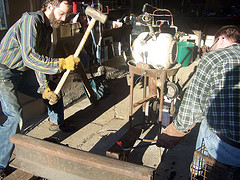Understanding Ferrous Metallurgy and Sheet Metal
 Ferrous metallurgy at first seems like a fancy, and perhaps antiquated, art form. But it is just a technical way of saying ironwork. Ferrous is a word derived from the Latin word ferrum, and simply refers to substances containing or consisting of iron. Ferrous metals include steel and pig iron (with a carbon content of a few percent) and alloys of iron with other metals (such as stainless steel). The term non–ferrous is used to indicate metals other than iron and alloys that do not contain an appreciable amount of iron. Metallurgy is the branch of science and technology concerned with the properties of metals and their production and purification.
Ferrous metallurgy at first seems like a fancy, and perhaps antiquated, art form. But it is just a technical way of saying ironwork. Ferrous is a word derived from the Latin word ferrum, and simply refers to substances containing or consisting of iron. Ferrous metals include steel and pig iron (with a carbon content of a few percent) and alloys of iron with other metals (such as stainless steel). The term non–ferrous is used to indicate metals other than iron and alloys that do not contain an appreciable amount of iron. Metallurgy is the branch of science and technology concerned with the properties of metals and their production and purification.
The History of Ferrous Metallurgy:
Working with iron has a rich and detailed global story. Metalworking began well before humans began recording history. The use of iron was known during the first millennium. The earliest metal objects were found in China from the second millennium and were made of iron and nickel. Steel was first produced in antiquity. During the industrial revolution, new methods of producing bar iron without charcoal were devised and these were later applied to product steel.
In the late 1850s a new steel making process was implemented which involved blowing air through pig iron. Iron smelting – the extraction of usable metal from oxidized iron ores – is more difficult than other elements, like nickel. Smelted iron requires hot working and can be melted only in specially designed furnaces.
Until the 19th century, steel was an expensive commodity and only used when a particularly hard or flexible metal was needed. The widespread availability of inexpensive steel powered the Second Industrial Revolution and allowed for the development of modern cities. Mild steel ultimately replaced wrought iron for almost all purposes, and stainless steel was developed on before World War I and was not widely used until the 1920s.
Today, steel is one of the most common materials in the world, with more than 1300 million tons produced annually. It is a major component in buildings, infrastructure, tools, ships, automobiles, machines, appliances, and weapons.
The Evolution of Steel and Modern Metalworking:
Iron gave way to steel and steel gave way to modernity. Stainless steel, as well as aluminum, has been used in the form of sheet metal, which is metal formed into thin and flat pieces. Now, companies have facilities that create custom components for a broad spectrum of industries: agriculture, communications, electronics, material handling, medical, lighting, machinery, printing, and others. They employ many sheet metal fabrication techniques, such as laser cutting, shearing, punching, press brake forming, and wielding assembly, among others.
The manufacture and distribution of iron and sheet metal are as varied as their application. They have been used in nearly every industry, from food production to housing, and continue to have a dramatic impact on mankind throughout the world.





Рейтинг популярности - на эти заметки чаще ссылаются:
- 43 Герой социалистического труда
- 42 Известный телеведущий целую неделю снимал о Южном Урале
- 41 Первый чугун на каменном угле
- 39 Механизация очистки горновых канав
- 38 Замена конвейерных лент
- 36 Отработка верхнего шлака
- 34 Безотходное производство чугуна
- 33 Металлургия России: всем выйти из кризиса Читать полностью:
- 33 Ремонты чугунных и шлаковых канав
- 33 Системы программного управления